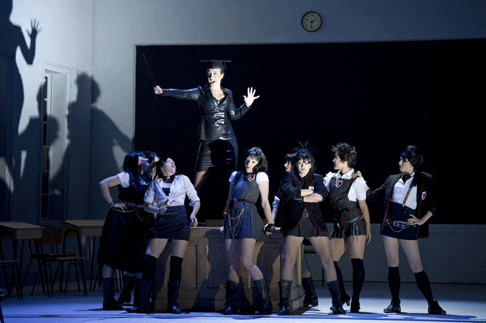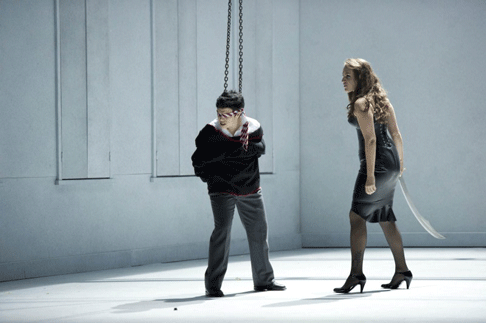The catch is that the staging is bizarre. Baroque is, by nature, bizarre and
“fantastikal” to use antique terminology. Baroque audiences went to the
opera to be stunned by spectacular feats and outrageous plots. Rinaldo has
inherent dramatic promise — malevolent magic, beauties and heroes, exotic
strangers, sex, battlefields and scene changes so extreme that they couldn’t
be done literally, especially given the limits of baroque stage production. In
many ways, baroque audiences had greater tolerance for fantasy than we do now.
Rinaldo is set in the Crusades but has nothing to do with history,
religion or even common sense. By removing the hero Rinaldo, the defenders of
Jerusalem think they can end the war. So Almira magics him off to an enchanted
island, far from the deserts around Jerusalem. Strange Realpolitik. Goffredo
and other Christians rescue him and all ends well.
So why the literal staging in this new production directed by Robert Carsen,
designed by Gideon Davey? It predicates on the notion that Rinaldo is a
schoolboy in a boarding school, who gets bullied by his classmates and caned by
his teachers. Indeed, caning recurs frequently in this production, which does
make one wonder. The schoolboy concept is largely irrelevant to the very adult,
sophisticated nature of Handel’s narrative, and feels forced and
infantile.
The sirens don’t need to be coy schoolgirls, and the sight of Almirena in
a maxi skirt gymslip is just absurd. The best images would work fine without
any schoolboy silliness. For example, Rinaldo and his friends march off not on
horses but on bicycles, Rinaldo suspended in the air on high wires. Had they
been dressed as warriors, the irony would have been even more pointedly
irreverent.
Although Rinaldo is funny, its deeper levels would not have been lost on
baroque audiences. Handel, through Torquato Tasso, is also obliquely mocking
the futility of war and power games. If even Almira the dominatrix Queen can
make up with ferocious philanderer Argante, there’s hope for all.
Ottavio Dantone conducted the Orchestra of the Age of Enlightment, one of
the finest specialist period instrument orchestras in the world. Extremely high
playing standards, though I would have liked Dantone to have injected more
punch overall, though the Battaglia was vivid. Handel’s instrumentation is
lively and inventive. Harpsichord, not only as continuo but as a quirky voice
in itself, and in this acoustic, assertively clear. Good growling percussion
and brass for thunder and battle. I was so intrigued by the bird-like
instrumentation around Almirena’s “Augelletti, che cantate”, that I went
up to the pit at the interval to check what it was.The musician wasn’t there
but other members of the orchestra were enthusiastic. “It’s a sopranino”,
someone said. “Not a flute, not a recorder”.
 Brenda Rae as Armida with Glyndebourne Chorus and dancers
Brenda Rae as Armida with Glyndebourne Chorus and dancers
Sonia Prina sang Rinaldo. She’s a very experienced Handel singer, so the
production was perhaps designed around her, much as the recent Glyndebourne
Die Meistersinger von von N¸rnberg reviewed here,
may have been created to enhance Gerald Finley’s voice. She and director
Carsen have worked together before. Prina’s short, compact and sassy, so
looks convincing as a schoolboy, Hers isn’t a transcendentally glowing
Rinaldo but she has stamina. In “Cara Sposa”, she stretched the long vowels
sturdily.
As Armida as Dominatrix, Brenda Rae looked the part in tight black rubber
and vertiginous stilettos. The characterization made an asset of the sharpness
at her top, but attention should be on the singing, not the fetish.
 Sonia Prina as Rinaldo and Brenda Rae as Armida
Sonia Prina as Rinaldo and Brenda Rae as Armida
Argante can be a relatively small part, but Luca Pisaroni made it central,
by the sheer force of personality in his singing. His voice has great depth and
range and is used intelligently. Pisaroni understands the purpose of the
elaborate ornamentations Handel wants in the part. When he sings “Sibillar
gli angui d’Aletto”, his variations are richly roccoco, emphasizing
Argante’s status as ruler, and the complexity of his character. Thus, when
Argante is humbled by his feelings for Almirena, Pisaroni’s voice becomes
gracious and tender. Pisaroni doesn’t sing when he’s strung up by Armida,
but his body language conveys feeling, twitching with anguish, even though his
face is hidden. Restored, he becomes the virile, dignified leader he was
before, as Pisaroni’s firm, well modulated singing in the Act 3 duet
demonstrates. This Argante is more than a match for Armida. (Please read the
interview he gave Opera Today here).
Varduhi Abrahamyan sang Goffredo. Being an admirer of countertenors, I was
delighted by William Tower’s Mago and Tim Mead’s Eustazio.
Perhaps there’s a much better production inside this Glyndebourne
Rinaldo, waiting, like the eponymous hero, to be set free. Handel’s
music is inherently dramatic, so the concert performance planned for the BBC
Proms on 25th August will be a much better opportunity to appreciate this
production. It’s being broadcast live, online, on demand and internationally.
A DVD is also planned, and the filming may reshape the staging so it comes over
more effectively, enhancing the musical values oif this production.
For more information, read the Glyndebourne Festival site and the BBC Proms site.
Anne Ozorio
image=http://www.operatoday.com/300cbc201106270950.gif
image_description=Brenda Rae as Armida and Luca Pisaroni as Argante. [Photo by Bill Cooper courtesy of Glyndebourne Festival 2011]
product=yes
product_title=G F Handel: Rinaldo
product_by=Rinaldo: Sonia Prina, Goffredo: Varduhi Abrahamyan, Eustazio: Tim Mead, Almirena: Anett Fritsch/Miriam Khalil (9th July), Armida: Brenda Rae, Argante: Luca Pisaroni., Mago: William Towers, Conductor: Ottavio Dantone, Orchestra of the Age of Enlightenment. Director: Robert Carsen, Designer: Gideon Davey, Lighting: Peter Van Praet, Movement: Philipe Girardeau, Dramaturg: Ian Burton. Glyndebourne Festival, Lewes, Sussex.
product_id=Above: Brenda Rae as Armida and Luca Pisaroni as Argante.
All photos by Bill Cooper courtesy of Glyndebourne Festival 2011.